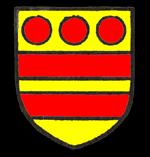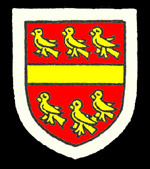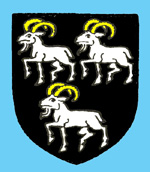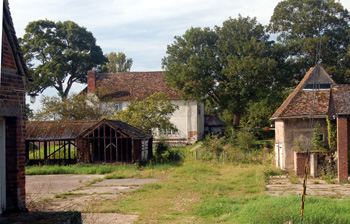Colmworth Manors

Coat of arms of the Barony of Bedford
Hugh de Beauchamp owned Colmworth at the time of the Domesday Book and this holding later became known as the Manor of Colmworth. The overlordship of the manor passed to Ela de Beauchamp in 1265. She was the wife of Baldwin Wake. Ela had three daughters Ida de Steyngreve, Elizabeth de Hoobury and Joan Picot, who each inherited a third of overlordship of this manor.
Ida's third share descended to her daughter Isabel, who was succeeded by her son John de Patishull. He also inherited half of Elizabeth de Hoobury's third share on her death in 1314, thus making his third share of overlordship of the manor into a half share. John's son William died in 1360 and left his share to his sister Alice, wife of Thomas Wake. The Wake family held half the overlordship until at least 1454.

Wake family coat of arms
Joan Picot's third share passed to her brother-in-law John Picot on her death. He had also inherited half of Elizabeth de Hoobury's third share in 1316. This half share of the overlordship of the manor remained in the Picot family until the fifteenth century. The overlordship is last mentioned in 1515
Wimund was the tenant at the time of Domesday Book and it is known that in 1167 a Roger, son of Wimund held lands in Bedfordshire. Early in the 13th century Robert de Taisso may have been the tenant. It is certain that the Oyldeboeuf family (spelt in a bewildering variety of ways but meaning bull's eye) were tenants of the manor by 1261. About 1275 the manor was divided into two parts. One part went to the Braybroke family and the other to the Longueville family. The likeliest explanation for this would be that the last Oyldeboeuf left two daughters who married into one each of the succeeding families.
Sir John Braybroke held half the former Oyldeboeuf lands in 1283 and was succeeded by his son Gerard who held it in 1316. By 1324 Gerard's son, also Gerard, held the Braybroke half of the manor. He was succeeded by his son, another Gerard, in 1350. This third Gerard died in 1359 and at this date Margaret de Longueville married a fourth Gerard de Braybroke, reuniting the manor in their son, inevitably another Gerard, who died in 1389. On the death of yet another Gerard de Braybroke in 1422 his daughter Elizabeth, who had married Sir William de Beauchamp, inherited the manor.

Beauchamp family coat of arms
Sir William Beauchamp was created Lord Saint Amand in 1448 in right of his wife, she was granddaughter of Almaric, Lord Saint Amand. Sir William died in 1457 and his widow Elizabeth then married Sir Roger Tocotes. Who died in 1492, a year after Elizabeth. The manor then passed to Elizabeth's son by Beauchamp - Richard, Lord Saint Amand who held the manor at his death in 1508.
The manor then passed to Thomas Brooke, son of Richard Beauchamp's cousin John, Lord Cobham. Brooke died in 1529 and was succeeded by his son George, Lord Cobham. His son William alienated the manor William Tocke or Tooke in 1565 and he transferred it, two years later, to Sir James Dyer, Chief Justice of the Court of Common Pleas.

Dyer family coat of arms
By 1603 Sir James Dyer's grandson, Sir Richard Dyer, held the manor and on his death in 1605 it passed to his son William. William died in 1621 and was succeeded by his elder son Lodowick, who was created a baronet in 1627. In 1659 Sir Lodowick mortgaged the Manor of Colmworth to Margaret Moore of Maydencott, Berkshire for the large sum of £1000 [BS492]. It’s probable that this resulted in William Dyer, Lodwick’s nephew and heir, later conveying the manor of Colmworth to Thomas Hillersdon in 1677/78 [BS499].
The manor remained in the Hillersdon family until 1725 when Elizabeth Hillersdon married Dennis Farrer and their son, also Dennis, alienated the manor to Francis Astrey in 1741. From him the manor passed to the Ray family until 1796 when it was purchased by Rev. Leonard Towne, from Lincolnshire [Z218/1]. He died in 1827 and the manor descended to his daughter Sarah Elye, wife of Rev. Thomas Norris [Z218/4]. This couple had six children and in 1861 a family settlement in which Colmworth Manor was vested in the three youngest - Sarah, Frances and John [Z218/30]. John married Albertina Starey of islington [Middlesex] in 1866 and his share of Colmworth Manor was conveyed to trustees [Z218/34]. The two sisters devised their shares to John's children - Frances before her death in 1869 [Z218/36] and Sarah before her death in 1880 [Z218/40].
In the 1920s a series of Law of Property Acts ended copyhold tenure and abolished manorial fines and incidents. Thus manors themselves were abolished in all but name.

Manor Farm and barns August 2009
The Site of the Manor
The site of the manor house seems to be at Manor Farm and close to the church, just the sort of position one would expect for a manor house. The description given in the Bedfordshire Historic Environment Record [HER 471] is as follows: "The site includes the remains of a medieval moated enclosure with separate fishponds and fowling earthworks. The moat consists of a 50 metre square raised platform with a ramped entrance on the north-east side. The original surrounding ditches are currently limited to a short section along the south-west side. An irregular pond at the north-west angle may be a later addition. The platform contains the upstanding remains of the post medieval manor house (which is excluded from the scheduling, although the ground beneath it is included). A curved outer moat extends to the south east from the ditched south east angle of the moat. This extension partially encloses a square subsidiary building platform and is thought to be part of the original design. The remains of contemporary fishponds can be seen south of the moat along 160 metres of the Colmworth Brook. These form a series of three ponds of various shapes and forms, two on the north bank and one on the south".
Another Colmworth Manor
Another Colmworth Manor is also mentioned in the 15th century. The overlords seem to have been the Beauchamps, Lord Saint Amand and in 1487 the tenant was Agnes Paston, who passed it on to John Harvey, son of her first husband. The only other mention of this supposed manor is in 1554 when held by Gerard Harvey.